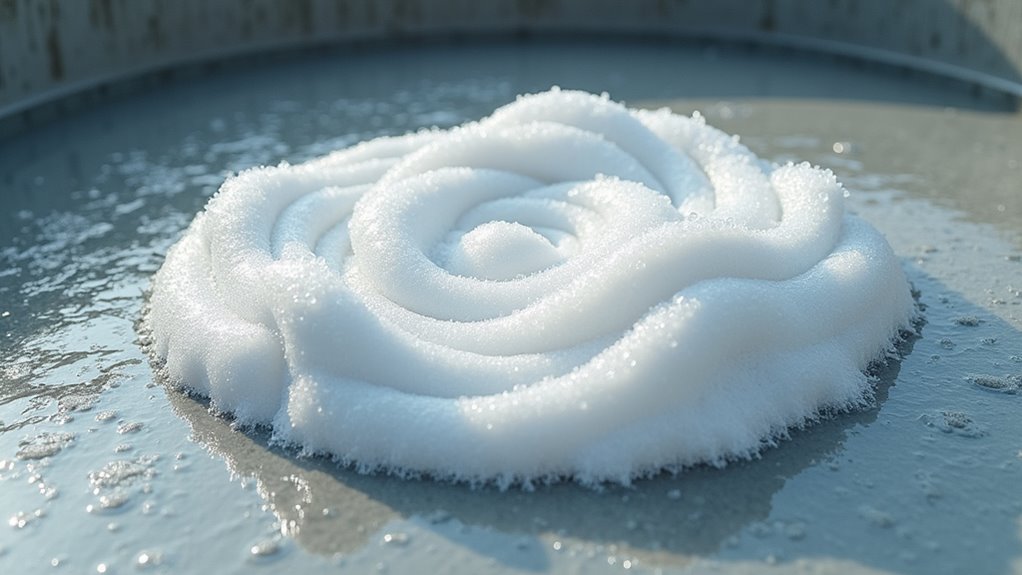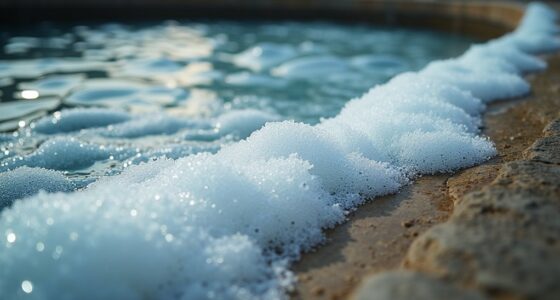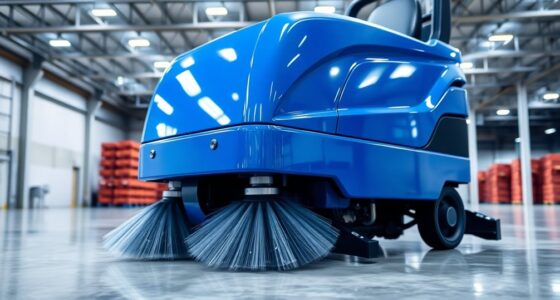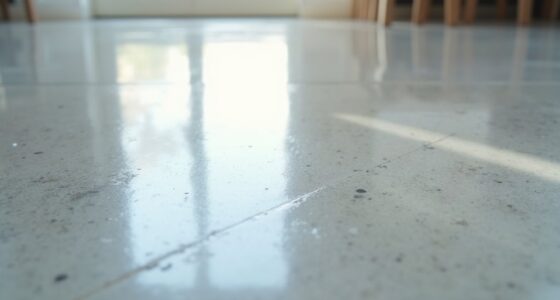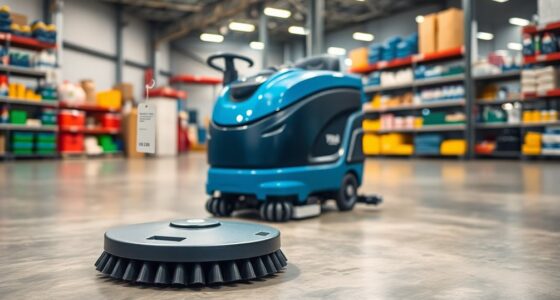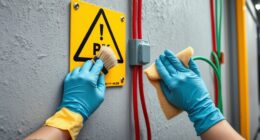Foam in your recovery tank on polished concrete often comes from chemical interactions, surfactants, or residues that create stable bubbles. Using cleaning agents with foaming agents or incompatible chemicals can worsen this issue. Regularly cleaning and maintaining your equipment helps reduce contaminants that cause foam. Selecting formulations with defoaming properties and ensuring proper chemical proportions are key steps. If you want effective, long-lasting solutions, explore how proper chemical choice and maintenance can keep foam at bay.
Key Takeaways
- Use a compatible defoamer formulated to reduce foam in recovery tanks on polished concrete surfaces.
- Regularly clean and inspect tanks to remove residues and prevent foam nucleation sites.
- Adjust chemical proportions and avoid incompatible mixes that can increase foam formation.
- Select cleaning agents with low or no foaming surfactants to minimize foam during recovery.
- Maintain equipment and chemical procedures to ensure effective foam control and optimal cleaning performance.
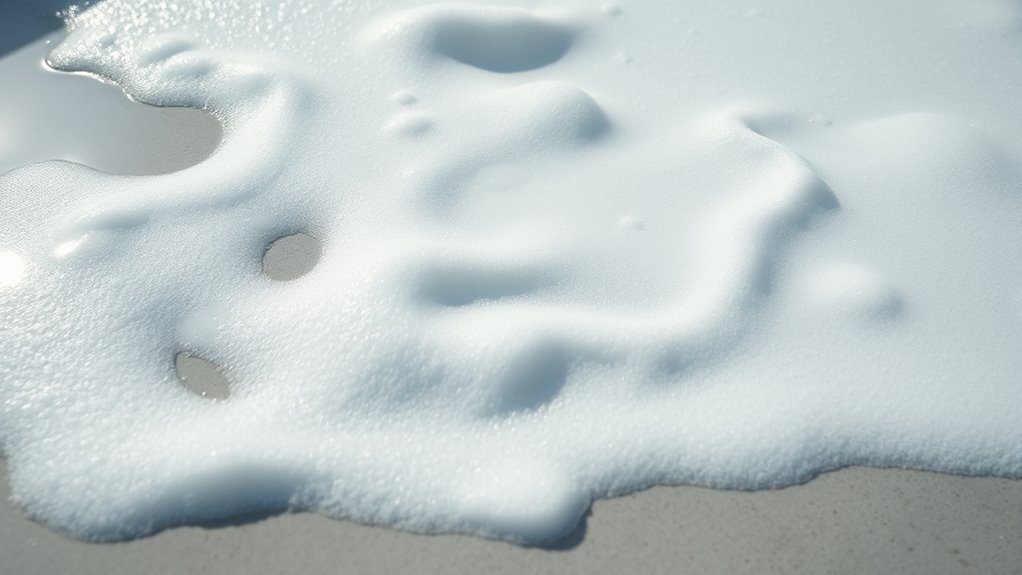
Have you ever noticed foam building up in your recovery tank and wondered what causes it? Foam formation is a common issue in polished concrete cleaning operations, and understanding why it happens can save you a lot of headaches. The primary culprit often lies in chemical interactions between cleaning agents and the surface or water used during the process. When certain detergents or surfactants are employed, they tend to create stable foam bubbles that persist in the recovery tank. These foaming agents, while effective for cleaning, can sometimes produce more foam than necessary, especially if not properly managed. The foam’s persistence can be exacerbated by residues left behind on equipment or the buildup of contaminants in the tank, which act as nucleation sites for foam formation. That’s why regular equipment maintenance plays a vital role; cleaning and inspecting your tanks and related components help prevent residual chemicals or debris from contributing to foam problems. Additionally, choosing formulations with defoaming properties can significantly reduce foam production during operations.
To keep foam under control, you need to pay close attention to the chemical interactions happening inside your recovery tank. Using the right proportion of chemicals and selecting formulations designed to minimize foaming can make a significant difference. Some cleaning solutions are formulated specifically with defoaming properties, reducing the tendency to generate excessive foam during recovery. Additionally, understanding how different chemicals interact with each other and with water can help you avoid creating conditions that promote foam buildup. For example, mixing incompatible chemicals can produce more foam or even cause chemical reactions that increase foam formation. Always follow manufacturer instructions and test small batches to guarantee the chemicals you choose work harmoniously without producing unwanted foam. Regular maintenance and proper chemical selection are key to minimizing foam issues and maintaining efficient operations.
Frequently Asked Questions
Can Foam Damage Polished Concrete Surfaces?
Foam damage can harm your polished surface if it’s not properly managed. When foam accumulates, it can cause streaks, discoloration, or surface etching on polished concrete. You should use a quality defoamer to control foam in your recovery tank, preventing potential foam damage. Regularly inspect your polished surface and address foam buildup promptly to maintain your concrete’s shine and prevent long-term damage.
How Often Should Defoamers Be Applied?
Back in the day, people used to wonder about defoamer application frequency. You should apply defoamers as needed, typically during your maintenance schedule, to prevent excessive foam buildup. Check the recovery tank regularly—if foam appears, it’s time for a quick application. Consistent monitoring guarantees your polished concrete stays in top shape. Adjust the frequency based on foam levels, but don’t overdo it—less is usually more.
Are There Eco-Friendly Defoamer Options Available?
Yes, eco-friendly defoamer options are available. You can choose biodegradable formulas made from plant-based ingredients, which effectively diminish foam without harming the environment. These products are safe for your equipment and the surrounding ecosystem, making them a responsible choice for maintaining your polished concrete recovery tank. Look for brands that prioritize sustainability and transparency in their ingredient sourcing to ensure you’re using truly eco-friendly solutions.
What Are the Signs of Excessive Foam Buildup?
You’ll notice excessive foam buildup as your tank overflows, spills, or creates a loud, persistent bubbling sound. Foam causes include soap residue, detergents, or agitation, while foam prevention involves reducing agitation and using proper cleaning agents. If foam persists or thickens unexpectedly, it signals overproduction. Recognizing these signs helps you address foam buildup early, ensuring your recovery tank functions smoothly and prevents costly cleanups or equipment damage.
Does Water Temperature Affect Foam Formation?
Yes, water temperature affects foam formation. When the water is warmer, it can increase foam production because heat reduces surface tension, making it easier for foam to develop. Conversely, colder water tends to decrease foam formation by stabilizing the liquid and limiting air entrapment. You should monitor water temperature closely, especially during cleaning or mixing processes, to control foam levels effectively and prevent excessive buildup in your recovery tank.
Conclusion
To keep your recovery tank foam-free, stay vigilant and address any foam buildup promptly. Using the right defoamer and maintaining proper cleaning routines can save you from bigger headaches down the line. Remember, a stitch in time saves nine—tackle foam issues early before they snowball into more significant problems. With consistent care and the right products, you’ll keep your polished concrete projects running smoothly and looking sharp.
